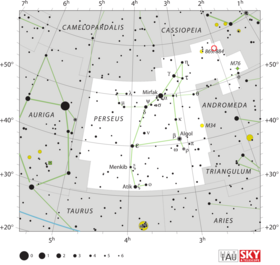V Persei
| Observation data Epoch J2000 Equinox J2000 | |
|---|---|
| Constellation | Perseus |
| Right ascension | 02h 01m 53.92s[1] |
| Declination | 56° 44′ 03.5″[1] |
| Apparent magnitude (V) | 4?[2] Max. 18.1 – 19.34[3] Min. |
| Characteristics | |
| Variable type | Classical nova + Eclipsing binary[4] |
| Astrometry | |
| Proper motion (μ) | RA: −44.184[1] mas/yr Dec.: −42.448[1] mas/yr |
| Parallax (π) | 0.2786 ± 0.1275 mas[1] |
| Distance | ≈ 1,000[3] pc |
| Absolute magnitude (MV) | 4.6[3] |
| Orbit[3] | |
| Period (P) | 2.57 hours |
| Semi-major axis (a) | 0.95 R☉ |
| Inclination (i) | 85.4° |
| Details | |
| White dwarf | |
| Mass | 0.85[4] M☉ |
| Radius | 0.0097[3] R☉ |
| Temperature | 10,000[3] K |
| Secondary | |
| Mass | 0.17[4] M☉ |
| Radius | 0.24[3] R☉ |
| Temperature | 3,300[3] K |
| Other designations | |
Nova Per 1887, AAVSO 0155+56[5] | |
| Database references | |
| SIMBAD | data |
V Persei, also known as Nova Persei 1887 was discovered by Williamina Fleming on a Harvard College Observatory objective-prism photograph taken on 3 November 1887.[2] It is believed to be the first nova whose spectrum was recorded.[3] The nova had an apparent magnitude of 9.2 at the time of discovery. Judging from the consistency of the nova's brightness after discovery, and details of the spectral lines seen, McLaughlin estimated that the nova was five or six months past peak brightness at the time of its discovery, and at its peak it was almost certainly at least as bright as 4th magnitude.[2] So V Persei was probably visible to the naked eye, though there is no record that anyone actually noticed it when that was possible. It is currently an 18th magnitude object.

All novae are binary stars, with a "donor" star orbiting so close to a white dwarf companion that matter is transferred from the donor to the white dwarf. Because the stars are so close together, novae are often eclipsing binaries, and V Persei shows such eclipses. That allows the orbital period, 2.57 hours, to be measured easily. The peak-to-peak brightness variation during the eclipse cycle is about 0.5 magnitudes.[3] Classical novae, like V Persei, are a type of cataclysmic variable star (CV) and the orbital periods of CVs have a bimodal distribution with peaks around 1.4 and 10 hours.[6] Few CVs have orbital periods between 2 and 3 hours. Because of this, V Persei's 2.57 hour period makes it a useful object for constraining models of CV evolution.[3]
In 1997 the William Herschel Telescope was used to search for a resolved shell surrounding V Persei, but none was found.[7]
References
- ^ a b c d e Vallenari, A.; et al. (Gaia collaboration) (2023). "Gaia Data Release 3. Summary of the content and survey properties". Astronomy and Astrophysics. 674: A1. arXiv:2208.00211. Bibcode:2023A&A...674A...1G. doi:10.1051/0004-6361/202243940. S2CID 244398875. Gaia DR3 record for this source at VizieR.
- ^ a b c Mclaughlin, Dean B. (June 1946). "Nova Persei (No. 1) 1887 (V. Persei)". Publications of the Astronomical Society of the Pacific. 58 (342): 218. Bibcode:1946PASP...58..218M. doi:10.1086/125817.
- ^ a b c d e f g h i j k l Shafter, Allen W.; Abbott, Timothy M.C. (April 1989). "V Persei: Bridging the Period Gap". Astrophysical Journal Letters. 339: L75. Bibcode:1989ApJ...339L..75S. doi:10.1086/185423.
- ^ a b c Haefner, R.; Fiedler, A. (2007). "Spectroscopy of the Faint Old Novae V per and V500 Aql". Information Bulletin on Variable Stars. 5751: 1. Bibcode:2007IBVS.5751....1H.
- ^ "V Persei". SIMBAD. Centre de données astronomiques de Strasbourg. Retrieved 2020-12-11.
- ^ Robinson, E.L. (1983). "The Periods of Cataclysmic Variable Stars". Cataclysmic Variables and Related Objects. IAU Colloq. 72: Cataclysmic Variables and Related Objects. Astrophysics and Space Science Library. Vol. 102. pp. 1–14. Bibcode:1983ASSL..101....1R. doi:10.1007/978-94-009-7118-9_1. ISBN 978-94-009-7120-2.
- ^ Sahman, D.I.; Dhillon, V.S.; Knigge, C.; Marsh, T.R. (August 2015). "Searching for nova shells around cataclysmic variables". Monthly Notices of the Royal Astronomical Society. 451 (3): 2863–2876. arXiv:1505.06048. Bibcode:2015MNRAS.451.2863S. doi:10.1093/mnras/stv1150. S2CID 62784187.

